I bought a spectra backpack from Dan McHale in 1993. All of Dan's packs are made to order, and built to your dimensions. I had worn out a few cheaper backpacks, and I decided I wanted a spectra one. Spectra is a strong, very abrasion resistant fabric (10 x more than nylon) which is made of ultra high weight molecular weight polyethylene fibers. It is difficult to work with (sew) due to a low melting point (around 330F, though it becomes dimensionally unstable around 200F) and it is expensive to waterproof. Since for me, abrasion was the major source of wear in a pack, spectra seemed like a good idea. (It is also the material of choice for bullet-proof vests, recently making it in short supply). In addition, other backpacks had not been super comfortable. McHale said his custom backpack with a superior belt and suspension system were very comfortable.
The backpack is very comfortable. It fits me perfectly. A friend who is of similar size, tried it for a few hours (helping me out of the Sierra when I had HAPE), and liked it so much he bought a larger one. The lid of the pack is removable and you can convert it into a fanny pack for dayhikes. Once I had some minor back pain, and I was scheduled to do a desert backpack (a heavy pack due to lots of water). I was able to get the pack on, and I found my back hurt less with the pack on than with the pack off. The trip was uneventful. One can strap a variety of things on the outside, including the optional side pockets, water bottles, and more.
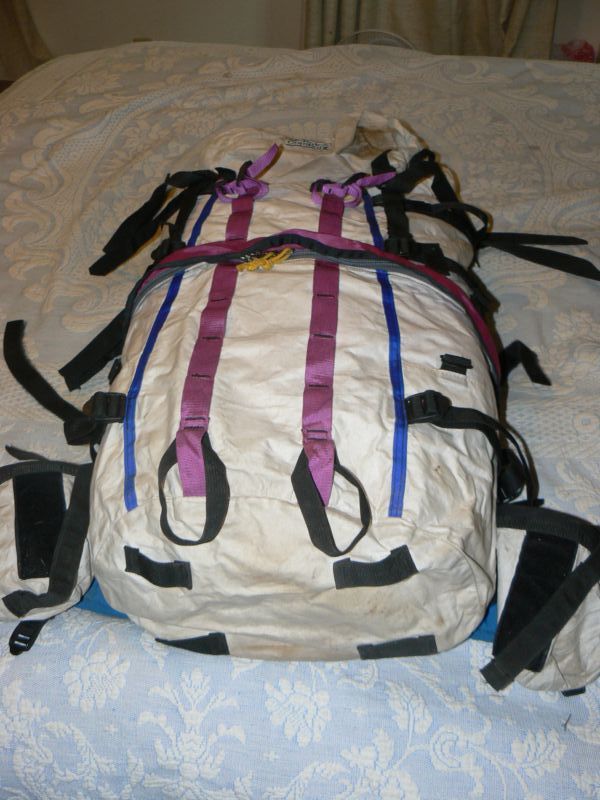
Here you can see the pack's bottom. There are places on the bottom to attach straps for carrying things outside the pack (the four black patches). The problem is the object is likely to hit your butt. Also visible are two pink daisy chains with a loop at the bottom for carrying an ice axe. The pack has a zipper which goes from side to side, and is covered by a pink nylon flap. There are three compression straps per side, and some other straps and mounting points visible.
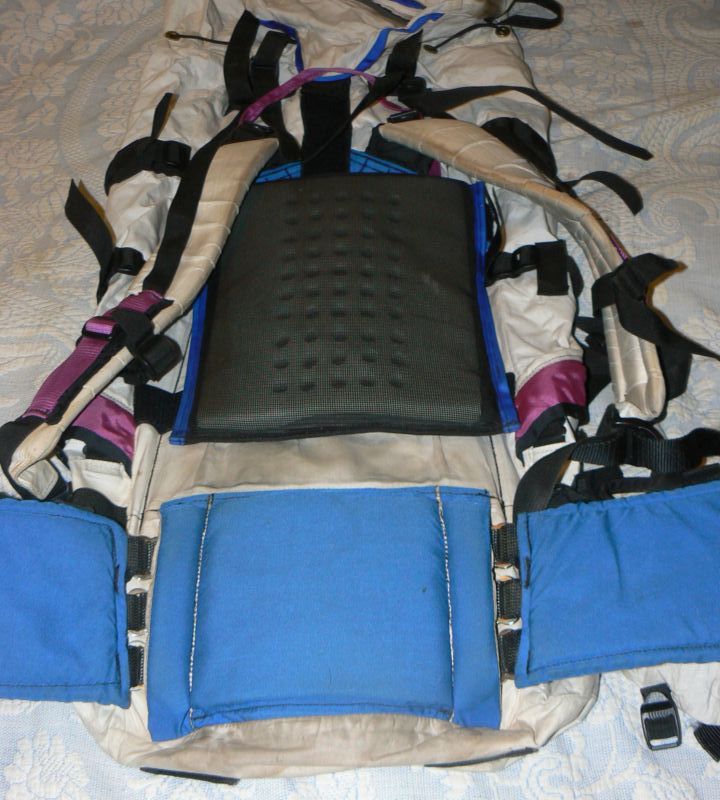
Here you can see the front of the pack. There is a prominent lumbar pad in blue attached to the pack. The hip belt straps to the pack using metal rings on each side of the lumbar pad. There is a back pad, which is made of foam with holes drilled in it, and covered in heavy mesh. It is detachable from the pack to form a small seat. The shoulder straps are straight and feature Dan's 'bypass' system. This allows the shoulder straps to be adjusted separately from the straps used to snug the top end of the pack against the top of your pack. (The details of this are not clear in this picture). The top lid is secured to the pack with two 1 inch straps as well as a piece of 2 inch wide velcro.
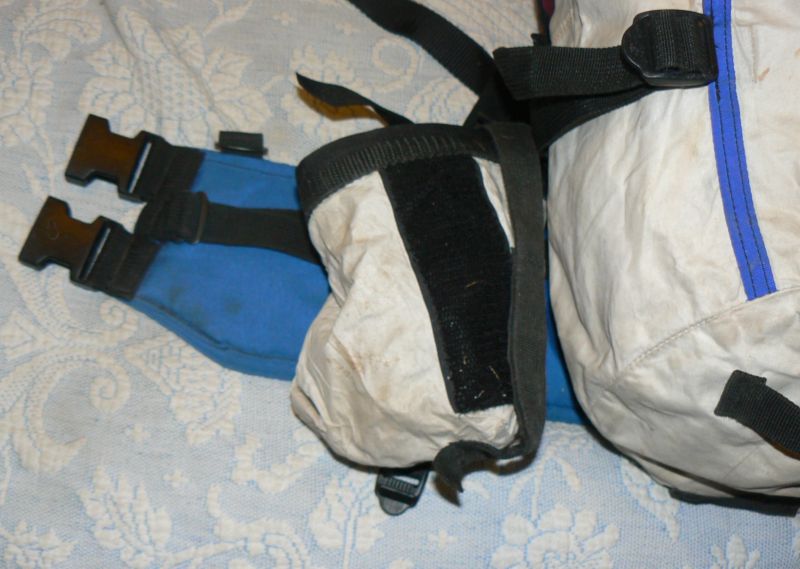
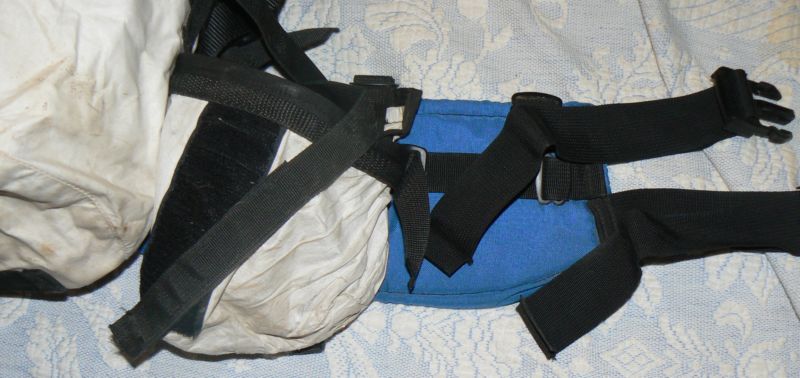
Here you can see the outside of the hip belt. I have attached two spectra water bottle holders to the belt, although there are many places on the pack where the holders could be attached. There is a stiffening black rim, and a wide velcro area with a strap to secure the bottle. The belt itself is quite high, which allows for very good weight distribution. Also note the two buckles for the belt. This allows the curvature of the belt to very closely mirror the curvature of your hips. This allows for a good fit for everyone.
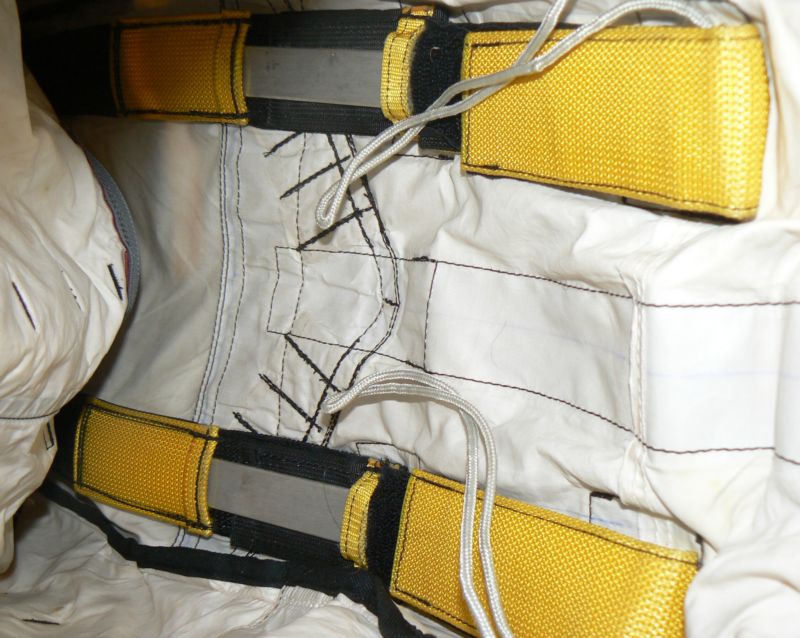
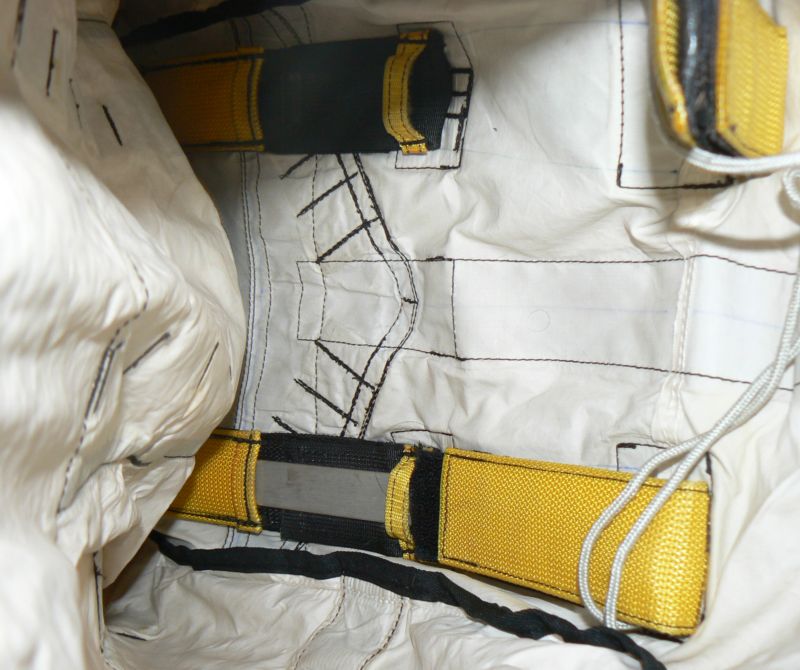
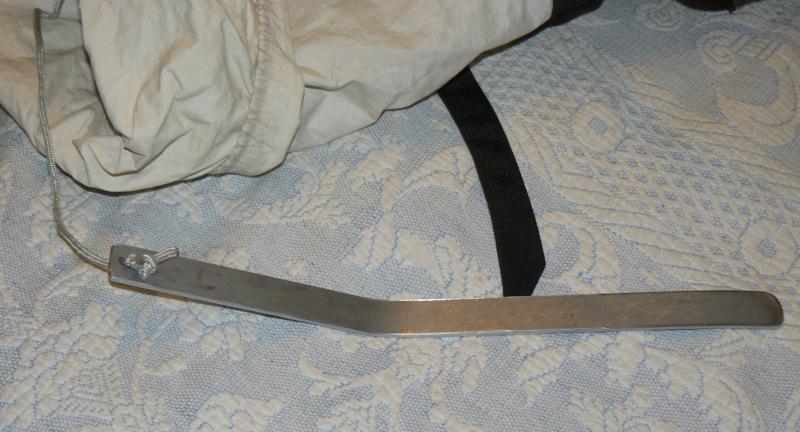
Here you can see the interior of the pack, and how the frame is secured to the pack. The black webbing is sewn to the pack. The yellow webbing on the bottom is also sewn to the pack. The aluminum pieces that comprise the frame are in between the black and yellow webbing. Each frame stay consists of two pieces (Dan calls this a 'bayonet' stay). For dayhikes, one can remove the top part of the stay, and make the pack smaller and more manageable. The second picture shows the top part of one stay removed, and the yellow webbing where the stay was can fold up in the pack. The third picture shows the removed top part of the stay, which is roughly 1 inch by 1/8 inch, 7071-T6 aluminum. Looking inside the pack, the quality of the workmanship is clear. For example all the seams are covered in seam-tape (the black line on the upper two pictures next to the stays.
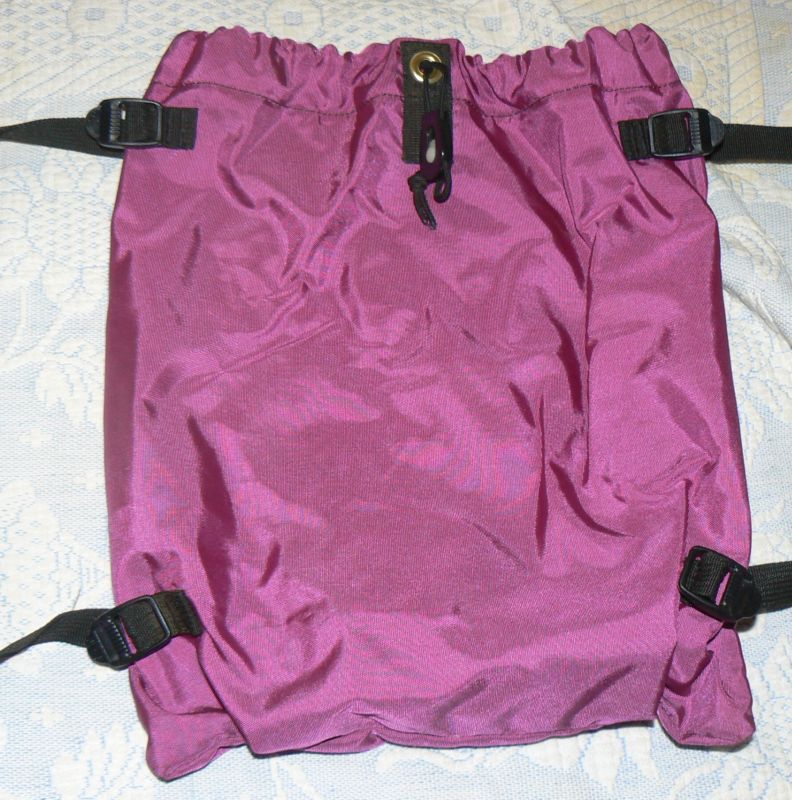
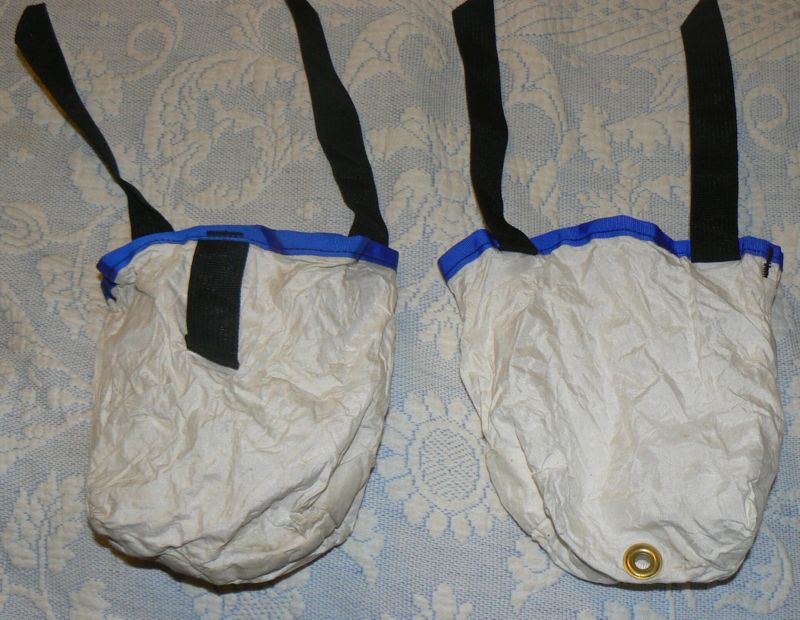
Here you can see the snow shovel pocket. This straps on the the back of the pack. Of course, it can be used for other things. Also shown are the snow picket pockets. These go near the bottom of the pack on either side and can be used to hold snow pickets. I have never used either of these accessories.
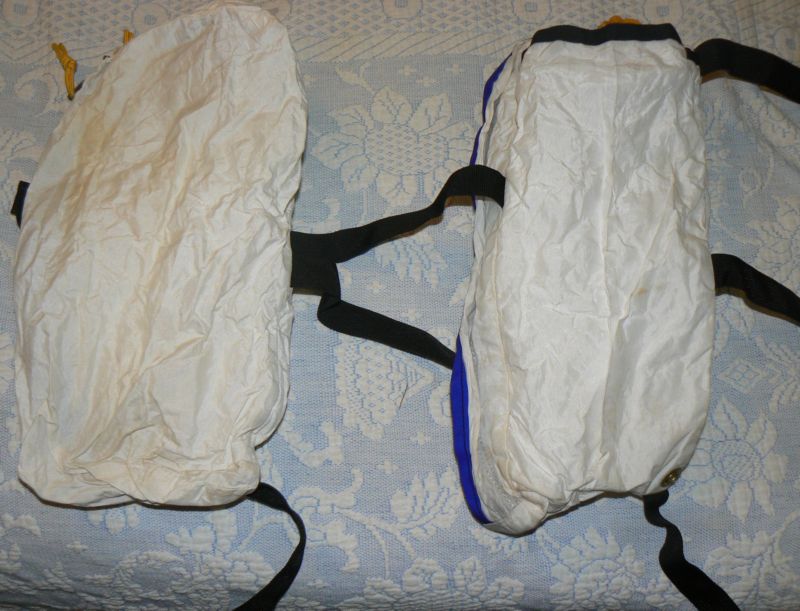
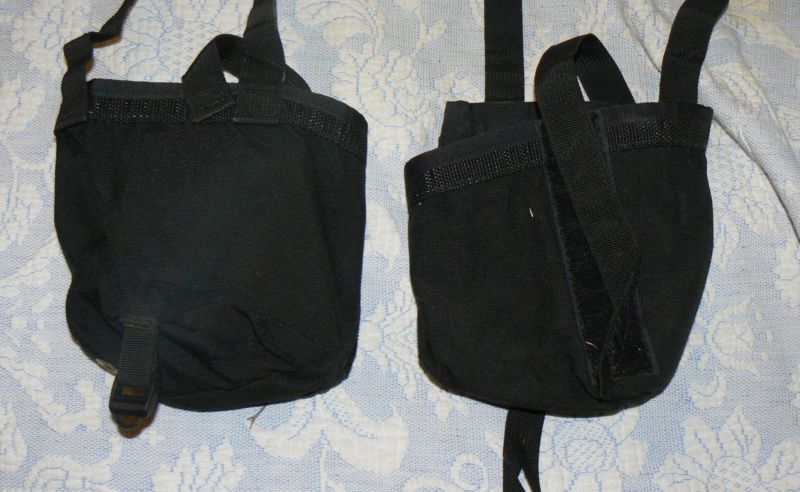
Here you can see the 'standard' sized side pockets, front and rear. They strap on the sides of the pack. There is a sleeve which is closed at the bottom, on the side that goes against the pack. I am not sure what this is for, perhaps it is for holding skis? I also have a pair of black nylon water bottle holders. These can be strapped on the sides of the pack, for a total of 4 liters of water bottle holders. This pack pre-dated the popularity of hydration bladders. Perhaps I will retrofit my pack for a 100oz hydration bladder. Not shown is a waterproof nylon cover for the whole pack in case of heavy rain.
After using my Spectra pack for several years, and many backpacks I finally had a small problem. The divider in the top lid of the pack ripped. Specifically the fabric (which was inside the pack and so was nylon, not spectra) failed along the seam where it was sewn to the spectra pack. Since it was a divider inside the lid of the pack, the only effect was things inside the lid of the pack were less organized, and moved around a bit. This happened in 1997 while leading a 3 day backpack to the top of Mt San Grogonio.
I was a bit surprised, considering McHale's reputation of building bombproof gear. When I got back from the backpack, I called McHale. Dan said to send it in, which I did. He said to be sure to insure it, since they don't make spectra packs anymore. In about 10 days, I had the top back. Dan explained that the original nylon was not very tough in that application, and they had stopped using it. Except that the fabric looked shiny and new, I couldn't tell that anything was different. This is the fastest turn-around I have had for a backpacking company. This includes The North Face, Sierra Designs, Kelty and others.
I have used the backpack perhaps 50 times. I have cleaned it in my bathtub just using water a few times. People that see it think it is brand new. There are no signs of wear. It is very comfortable. It is easy to adjust. I used it for a 5 day backpack in the Grand Canyon, carrying 75 lbs without incident. I have used it to carry all my rock climbing gear (sharp heavy stuff) without incident. Perhaps one year when I get skinny, I will need a new waist belt because the old one will be too big. All of Dan's packs are designed to be as robust as possible. I suppose he could shave off a few ounces by using thinner webbing, or smaller fasteners. Perhaps if you ask him, he will build a pack with ultra-light stuff. I didn't get the pack to shave ounces, I got it to last. I am confident that nothing will wear out in my lifetime. Highly recommended.
If you have comments or suggestions, Email me at turbo-www@weasel.com
Created with gnu emacs and template-toolkit, not some sissy HTML editor.
No Java or javascript needed to view my web pages. They
both have significant security issues.